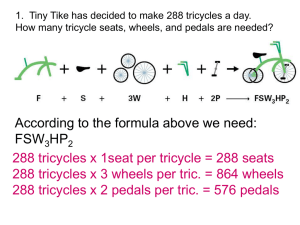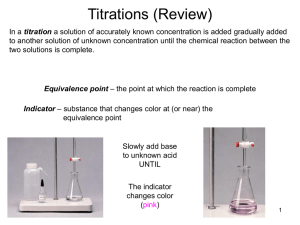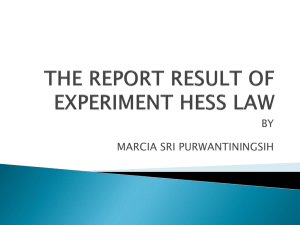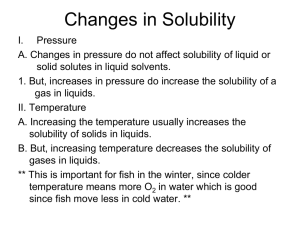7a - Titrations
advertisement
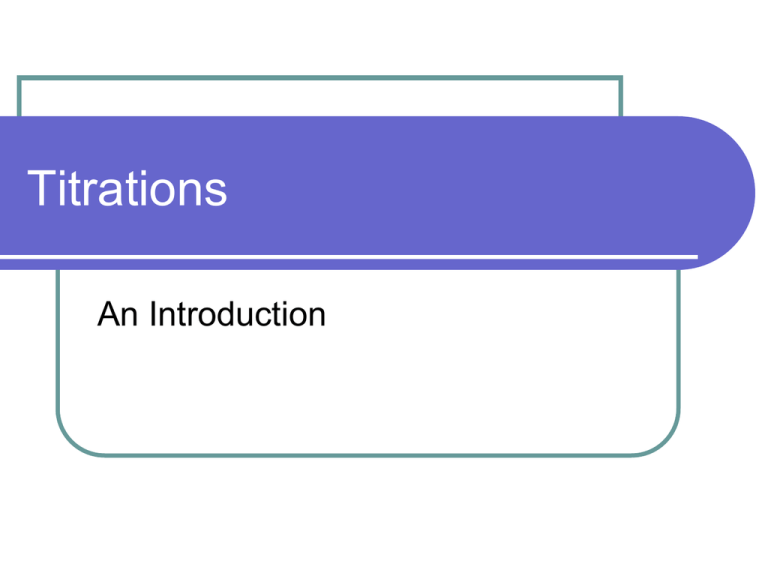
Titrations An Introduction Have a cookie… Remember my delicious cookie recipe: 1 cup flour + 24 choc. chips 3 cookies How many chips do you have? You know how many chips, without counting them because you know how many chips in each cookie! 2 cookies * 24 choc. chips = 16 choc chips 3 cookies Titrations This is the purpose of a titration: determining the thing you can’t see based on the thing you know. Usually, chemical titrations involve relating the reactants to each other rather than relating the reactants to the product (as we just did) Back to the Cookies If I used 8 cups of flour to make these cookies, how many chocolate chips did I have? 8 cups flour * 24 choc. chips = 192 chips 1 cup flour You’re sure? Of course you are! Even though we didn’t count the chips Titrations It’s all about the moles, folks! (Isn’t it always…) Suppose I have a solution of waste water and I need to know how much Compound A (like chocolate chips only toxic! ) is in it. How would you do it? Find something that reacts with Compound A in a known chemical reaction: A+2B→C This is a recipe, it gives an exact ratio between the moles of A and B. So if I know how much B I add to the sample to get it to all react, then I know how much A was there when I started! Known vs. Unknown A+2B→C Well, if I add “B” to the sample, what will happen? If I add “B” to the sample, it should form “C” but only if… …I have “A” A+2BC B So, I start with “5 As” in my beaker and then add B to it. A What happens? A+2BC B After I add 2 Bs, I get one C… A A+2BC B After I add 4 Bs, I get two Cs… A A+2BC B After I add 6 Bs, I get 3 Cs… A A+2BC B After I add 8 Bs, I get 4 Cs… A Watching A: B After I add 10 Bs, I get 5 Cs… A A+2BC B A After I add 1,000,000 Bs, I get 5 Cs. As soon as I ran out of A, the amount of B becomes irrelevant! I can’t make C without both A and B! Completion of the Reaction A+2B→C So, if I think A is there, I can add known amounts of B. If I form C, then there was A there. If I gradually add more known amounts of B until I stop forming C, then I’ll know how much A was originally there. How much? Equivalence Point A+2B→C I stop making C when Moles of B added = 2x moles of A original there! This is called the equivalence point! Titrations ALL titrations work the same way: You have an unknown amount of one compound (call it A). You have a known amount of a different compound (call it B). You know a chemical reaction that occurs between A and B. Add B until no more reaction occurs. The amount of A is stoichiometrically equivalent to B! The “tough part”: How do I know the reaction has stopped? 1. I get no new C. 2. I have no A left. 3. I have extra B left over. Watch A: B A 5A Watch A: B A 4A Watch A: B A 3A Watch A: B A 2A Watch A: B A 1A Watch A: B A 0 A! I’m DONE! Or you could watch B Watch B: B A 0B Watch B: B A 0B Watch B: B A 0B Watch B: B A 0B Watch B: B A 0B Watch B: B A 0B Watch B: B A 1 B! There it is! I’m DONE! Or you could watch C Watch C: B A 0C Watch C: B A 1C Watch C: B A 2C Watch C: B A 3C Watch C: B A 4C Watch C: B A 5C Watch C: B A Still 5 C! I’m DONE! A and B are easier to watch… …it’s more obvious if there is none vs. some. Acid/Base Titrations How does this work for an acid/base titration? What is the first thing we need to know? EXACTLY! The Chemical Reaction Acid-base Reaction In an acid/base titration, the generic reaction is: H+ + OH- → H2O H3O+ + OH- → 2 H2O An acid is a proton donor (H+) A base is a proton acceptor, is it always an OH-? Does it matter? H+ + OH- → H2O As I make water, by adding OH- to H+ (or H+ to OH-), the pH changes. How do I know that I’m done adding…? When I reach “equivalence” (I’m “done”), the pH should be… 7 (for strong acids/bases) Indicators of the endpoint You can use a pH meter to monitor pH. You can use chemical indicators to monitor pH. Some dyes change color when the pH changes. If you add a little bit of one of these dyes that changes color around pH = 7, then it will change color when you reach equivalence. Watch B: pH is low Watch B: B A pH is getting higher Watch B: B A pH is even higher Watch B: B A pH is even higher Watch B: B A pH is near 7 Watch B: B A pH is 7 Watch B: B A pH is over 7 pH vs. mL Base added pH 7 mL OH- added An example of titration. I have a 25.00 mL sample of an acid of unknown concentration. After addition of 13.62 mL of a 0.096 M NaOH solution, equivalence was reached. What was the concentration of acid in the original wastewater sample? Where do I start? Chemical Reaction: H+ + OH- → H2O At equivalence…? Moles of H+ = Moles of OH- added An example of titration. I have a 25.00 mL sample of an acid of unknown concentration. After addition of 13.62 mL of a 0.096 M NaOH solution, equivalence was reached. What was the concentration of acid in the original wastewater sample? What do I need to determine? Moles of OH- added! How do I figure that out? Molarity combined with volume! The solution 13.62 mL NaOH 1L = 0.01362 L NaOH added 1000 mL 0.096 M NaOH = 0.096 moles NaOH 1 L solution 0.096 moles NaOH * 0.01362 L = 1.308x10-3 moles NaOH 1 L solution What does that number tell us? How many moles of H+ were originally there! 1.308x10-3 moles NaOH added = 1.308x10-3 moles H+ in original sample An example of titration. I have a 25.00 mL sample of an acid of unknown concentration. After addition of 13.62 mL of a 0.096 M NaOH solution, equivalence was reached. What was the concentration of acid in the original wastewater sample? 1.308x10-3 moles H+ in original sample Am I done? Not quite. We need the concentration of acid: How do I calculate that? Molarity = moles/L An example of titration. I have a 25.00 mL sample of an acid of unknown concentration. After addition of 13.62 mL of a 0.096 M NaOH solution, equivalence was reached. What was the concentration of acid in the original wastewater sample? 1.308x10-3 moles H+ in original sample = 0.0523 M 0.02500 L original sample Basically the end… You can actually summarize this in an algebraic relationship…but IGNORE ME NOW if you understand the way we just did it. Equivalence Point If you have a reaction: iAA + iBB products One way of stating the molar relationship in the titration is: iB MAVA = iA MB VB Where M = molarity and V = volume and i = stoichiometric coefficient iB MAVA = iA MB VB This really just summarizes the calculation we did in multiply steps last time: MA*VA = moles A * moles B = moles B moles A moles B = MB*VB MA*VA * moles B = MB*VB moles A A little example A 10.00 mL sample of waste water is titrated to its phenolphthalein endpoint by addition of 36.32 mL of 0.0765 M NaOH. What is the pH of the original waste water sample? NaOH = Na+ + OH[OH-]=[NaOH] H+ + OH- = H2O 1*36.32 mL * 0.0756 M = 1*10.00 mL * X M X = 0.2745 M pH = - log [H+] Does the [H+] = [acid]? What if it’s a polyprotic acid? 0.2745 M of what? Of [H+] – we reacted the waste water with OH-, all we know is the equivalent amount of H+ - which is all we need to know to get the pH We don’t actually know what the acid (or acidS) were or what their concentrations are, we just know the H+. But that’s OK, the H+ is the active part of the acid! pH = - log [H+] pH = - log (0.2745 M) pH = 0.56 Another Little Problem Titration of 25.00 mL of a sulfuric acid solution of unknown concentration required 43.57 mL of 0.1956 M NaOH to reach equivalence. What is the concentration of the sulfuric acid? What do you need to notice about this problem? Sulfuric Acid (H2SO4) is a diprotic acid. If it helps… …write the balanced equation (a chemist would). H2SO4 (aq) + 2 NaOH (aq) → Na2SO4 (aq) + 2 H2O (l) Stoichiometry ALWAYS Matters 1*43.57 mL*0.1956 M = 2*25.00 mL * X M X = 0.1704 M H2SO4 If you wanted to calculate the pH…? You need to again consider stoichiometry: each H2SO4 gives 2 protons 2 [H2SO4] = [H+] 2*0.1704 M = 0.3408 M H+ pH = - log (0.3408) = 0.47 Acid-base Reaction Acid + Base H2O + salt HA + MB H-B + MA An acid is a proton donor (H+) A base is any proton acceptor – where’d the OH- come from? Acid-base Reaction It could come from the base: HCl + NaOH H2O + NaCl But, not all bases have an OH: HCl + NH3 ??? NH3 + H2O = NH4OH HCl + NH4OH H2O + NH4Cl You can always generate OH- in water, because water can always act as an acid. A little bitty problem… A 10.00 mL sample of waste water is titrated to its phenolphthalein endpoint by addition of 36.32 mL of 0.0765 M NaOH. What is the pH of the original waste water sample? (This is just another way to phrase the question.) Solution A 10.00 mL sample of waste water is titrated to its phenolphthalein endpoint by addition of 36.32 mL of 0.0765 M NaOH. What is the pH of the original waste water sample? 36.32 mL * 0.0756 M = 10.00 mL * X M X = 0.2745 M pH = - log [H+] Does the [H+] = [acid]? What if it’s a polyprotic acid? 0.2745 M of what? Of [H+] – we reacted the waste water with OH-, all we know is the equivalent amount of H+ - which is all we need to know to get the pH pH = - log [H+] pH = - log (0.2745 M) pH = 0.56 Another Little Problem Titration of 25.00 mL of an unknown sulfuric acid solution required 43.57 mL of 0.1956 M NaOH to reach equivalence. What is the concentration of the sulfuric acid? What do you need to notice about this problem? Sulfuric Acid (H2SO4) is a diprotic acid. If it helps… …write the balanced equation (a chemist would). H2SO4 (aq) + 2 NaOH (aq) → Na2SO4 (aq) + 2 H2O (l) This is sometimes written as a “net ionic equation”: H+(aq) + OH-(aq) → H2O (l) Stoichiometry ALWAYS Matters 1*43.57 mL*0.1956 M = 2*25.00 mL * X M X = 0.1704 M H2SO4 If you wanted to calculate the pH…? You need to again consider stoichiometry: each H2SO4 gives 2 protons 2 [H2SO4] = [H+] 2*0.1704 M = 0.3408 M H+ pH = - log (0.3408) = 0.47 An example of titration. I have a 25.00 mL sample of a wastewater. After addition of 13.62 mL of a 0.096 M NaOH solution, equivalence was reached. What was the concentration of acid in the original wastewater sample? The solution (13.62 mL) (0.096 M) = (25.00 mL) (X M) Is this correct? Units! Units! Units! M = moles/L If I want moles, I need to have Volume in L. But, since the only different is 10-3, if I have V=mL, then I have mmoles (10-3 moles) on each side. The solution (13.62 mL) (0.096 M) = (25.00 mL) (M2) 1.307 mmoles = 25.00 mL (M2) M2 = 0.0523 M Titration problem A 25.00 mL sample of wastewater of unknown pH is titrated with a standardized 0.1011 M NaOH solution. It takes 16.92 mL of the NaOH to reach equivalence. What is the pH of the original wastewater sample? MNaOHVNaOH = MH+VH+ (0.1011 M) (16.92 mL) = MH+ (25.00 mL) MH+ = 0.06842 M pH = - log [H+] = - log (0.06842) pH = 1.16 Another little problem A 25.00 mL sample of wastewater of unknown pH is titrated with a standardized 0.1011 M H2SO4 solution. It takes 16.92 mL of the sulfuric acid to reach equivalence. What is the pH of the original wastewater sample? 2 OH- + H2SO4 = 2 H2O + SO42ibaseMH2SO4VH2SO4 = iH2SO4 MOH-VOH(2)(0.1011 M) (16.92 mL) = (1) MOH- (25.00 mL) MOH- = 0.136 M pOH = - log [0.136] = 0.86 pH = 14 – 0.86 = 13.14 Weak acids The pH of an acid/base titration at equivalence is not always 7. (I lied, I admit it!) It’s only 7 if it is a “strong acid” and a “strong base”. What does “strong” mean in this context?
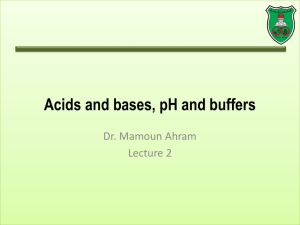


![pH = - log [H + ]](http://s2.studylib.net/store/data/005622524_1-002df1ea50d2a849b15deb604928664e-300x300.png)

